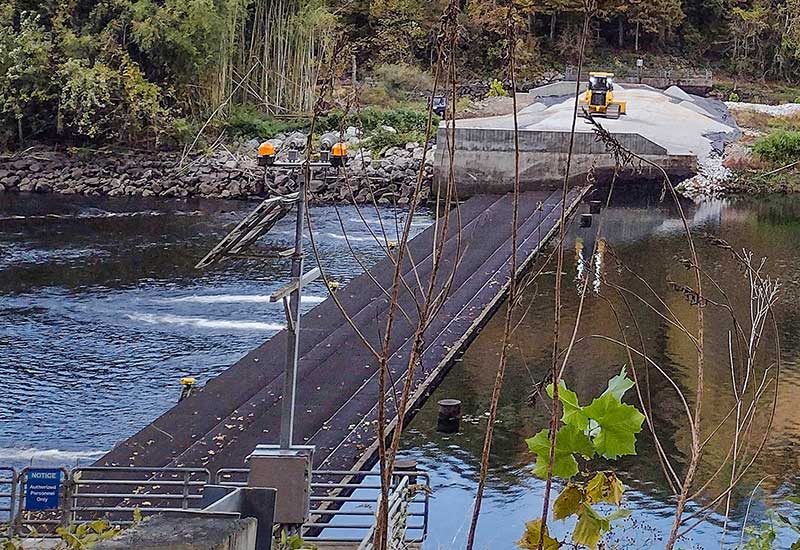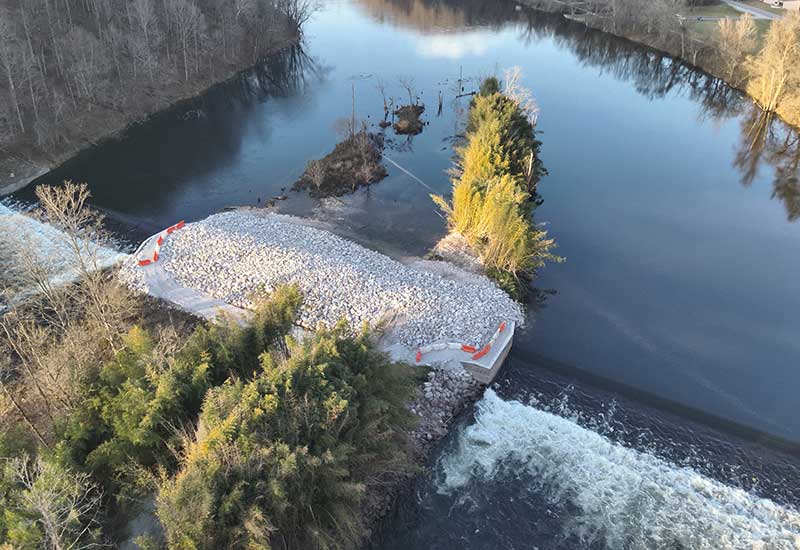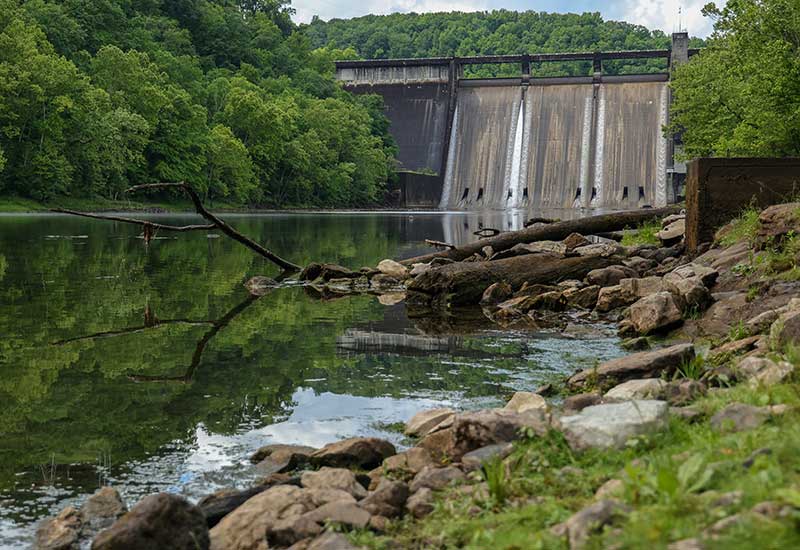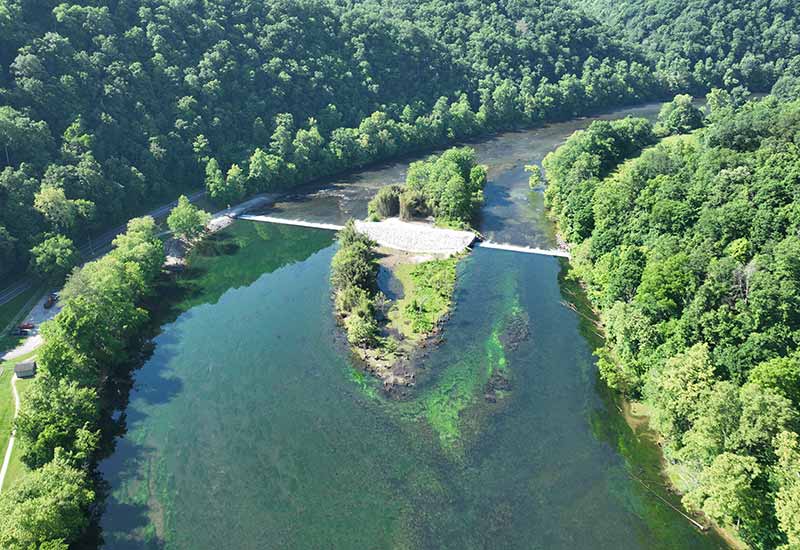Hibbs Island Rebuild Helps River Biodiversity
Towering walls of crafted concrete, Tennessee Valley Authority dams changed lives.
They stopped catastrophic flooding, electrified the region and created reservoirs in which people could play.
But that’s not the whole story.
Downstream from each TVA dam there’s a rich river world, home to trout fisheries and rare species of animals and plants.
It’s a playground for anglers, birders and boaters alike.
And it’s a river ecosystem that TVA scientists and engineers work hard to ensure has the right flow, temperature and oxygen levels for thriving fish and aquatic communities.
So when Jeffery Ogden, TVA Reservoir Release Improvement Program manager, noticed something amiss, he and his team took action.
Ogden and his support team suspected the cold, clear Clinch River below Norris Dam was eroding Hibbs Island.
That was a problem because the island anchored a critical weir – a low dam stretching across the river – that controls flow and oxygen.
“We finally got an opportunity to get a drone in the air and confirm our suspicion,” Ogden said. “During high flow events, the water had been passing through the island and between the weirs, so we were unable to direct part of the release over the weirs.”

TVA crews carefully rebuilt Hibbs Island with gravel and concrete to stabilize the two sections of weir dam, which help maintain oxygen-rich flowing water for fish and other aquatic animals.
Why Weirs?
Weirs help fish, mussels, snails, insect larvae and plants thrive.
During dam releases, engineers can inject oxygen into the deep, still water that flows from the dam.
Then, this water also rushes over the weir like a waterfall, further filling the river with bubbles of oxygen for fish to breathe.
Weirs also keep rivers from running dry.
“As the (water) level drops, you have a pool behind the weir,” Ogden said. “Then water will be released through a series of low-level pipes … to ensure a constant minimum flow downstream.”
But dams and weirs and engineers didn’t always work together in this way.
Scientists first began monitoring river life during the 1970s, when they quantified the past negative impacts of dams.
“We saw a lot of (change) early on,” TVA aquatic biologist Dave Matthews said. “The diversity and density of aquatic insect life by the 1970s was very low.”
TVA changed the way it operated its dam system for better biodiversity.
In the 1990s, the enterprise began its Reservoir Release Improvement Program.
“It didn’t all happen at once,” Ogden said, but TVA has spent about $135 million on improvements to date.
Based on 20 years of research, monitoring and working with federal and state partners, TVA changed where, when and how water flowed from dams.
When the region needed power or had a huge storm system, TVA balanced releases from multiple dams, rather than scheduling a large release from just one, so water didn’t flow too fast or too cold.
Engineers designed aeration systems and built weirs, such as the one at Norris Dam, to make sure reservoir waters bubbled with oxygen and flowed freely.
Today, 95% of TVA’s tributary dams have aeration or minimum flow technologies. They operate each spring through late fall.
“When they put in those (reservoir release) improvements, oh my gosh, (aquatic insect life) went up,” Matthews said. “It led to a world-class trout hatchery, just that act alone.”

Over time, the Clinch River started to flow over parts of Hibbs Island. Crews built up the island to redirect water over the weir dams
Rebuilding for River Health
If weirs matter so much to the biodiversity below Norris Dam, just how does one rebuild an island to ensure the water flows properly?
Ogden explained that the entire process – from the first drone flight in 2019, to combing through past river flow data, to drafting plans with the engineering firm Mesa Associates Inc., to hauling in soil and rock and carefully crafting a new portion of the island – took about five years.
Maximum flow release events mattered in planning a sturdy solution. How high and fast did water go?
From 2010 to 2020, Norris Dam’s total hourly flow release maximum was estimated to be 26,000 to 27,000 cubic feet per second, Ogden said.
It’s not only how much water was released from the dam, but also how often.
“In recent years, we’ve had several wetter than normal years,” Ogden said. “2018 through 2020 were the top three wettest years on record across the Tennessee Valley, with 2020 setting a new record for the most rainfall ever in the 131-year period of record.”
When water flows through the dam, it spins a turbine – a wheel – to generate power. That means a steady release of water to the tailwater below the dam.
In high flow events, which happen in spring or during rainstorms, TVA releases water beyond what’s needed to generate power.
Norris Dam can generate approximately 8,000 – 10,000 cubic feet of flow per second.
Because spilling – those big releases – means a lot of water all at once, engineers input the past flow rates and river heights into a computer model. That helped them know how high to rebuild the berm, or edge of the island, between the right and left river channel weirs.
Model results showed that if the river flowed at 30,000 cubic feet per second – higher than it’s ever flowed – the pool behind the weir could reach 831 feet at most, Ogden said.
That meant that they had to rebuild the berm at the island’s edge to an elevation of 831 feet. At that height, water would once again go around the island, flow over the weirs and tumble, bubbly, to the reaches of river below.
Mesa Associates offered TVA different rebuilding options. Ogden and his staff chose one that had the least impact on the island’s plants and animal residents, while helping the fish the most.
“It’s been a major effort … to haul the soil, haul the rock over to the island and then place it and compact it,” Ogden said.
And their efforts have paid off. In spring 2024, Hibbs Island opened as a stabilized island with a new soil and limestone berm.
“Now the weirs will function as designed, where all releases from the dam will flow over the right and left channel weirs,” Ogden said. “The goal of the project is to restore the function of the weirs.”
And the region’s residents – human and animal alike – can reap the rewards.
“Biologists definitely sing the praises of this program and the benefits it’s had on the water quality, which then affects aquatic life, fishermen and economic development,” Ogden said. “It really trickles down to where it does make a difference in the communities.
Photo Gallery

Weir dams form one part of TVA’s Reservoir Release Improvement Program, which ensures water released from Norris and other TVA dams is healthy for river life.

The Clinch River flows clear and cold from Norris Dam over these sections of weir dam at Hibbs Island.
